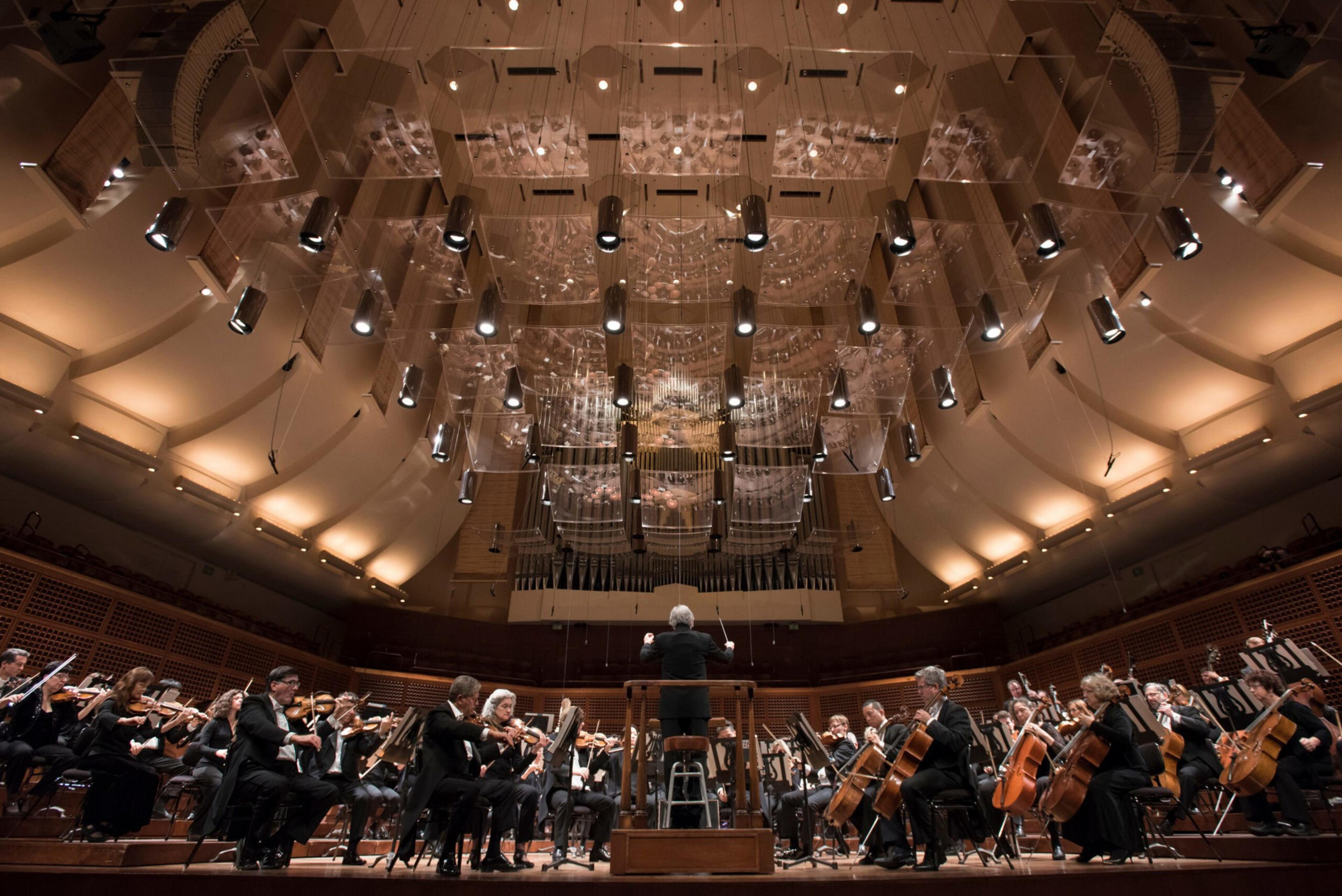In late February, Priscilla Geeslin, who goes by Prisca and is chair of the San Francisco Symphony Board of Governors, hosted a small dinner for large donors at her Pacific Heights home. The well-heeled group was treated to the perks of patronage: A lovely meal, a recital by the symphony’s newly arrived principal harpist, and a few remarks from its world-famous music director, Esa-Pekka Salonen.
A reserved Finn, the maestro and composer joined the symphony in 2020 after a much-praised, 17-year stint as leader of the Los Angeles Philharmonic. When his hiring was announced in late 2018 it was with high hopes that the San Francisco Symphony had found a successor to Michael Tilson Thomas, its beloved and longtime conductor.
Amidst a global pandemic and declining interest in classical music, however, things had not gone as planned. Salonen, despite the gaiety of the evening, was in no mood for pleasantries. “We are in danger,” he warned the room, “of becoming a regional orchestra.”
A symphony conductor informing patrons of a slide toward provincial purgatory would be like San Francisco Giants manager Bob Melvin telling the team’s owners they ought to play ball in Stockton. The benefactors were stunned. It was “as if a bomb dropped,” says Cynthia Hersey, who has endowed a chair at the symphony. “It let me know he was not a happy man. And it reflected his knowledge of the cuts that were coming.”
The cuts turned out to include the conductor himself. Two weeks after the posh gathering, the symphony announced that Salonen had chosen not to renew his five-year contract, due to expire in 2025. Salonen, as blunt publicly as he had been privately, said in a statement that he doesn’t “share the same goals for the future of the institution as the Board of Governors does.” He was referring specifically to the recent cancellation of a European festival tour scheduled for 2025, as well as reduced performances and commissions of new work.
The Salonen affair was a shocking embarrassment in the genteel world of classical music. How could the San Francisco Symphony abruptly and unexpectedly part ways with its renowned conductor? After all, just two days earlier, Salonen had been announced as the 2024 winner of the Polar Music Prize (opens in new tab), often referred to as the Nobel of classical music.
For the uninitiated, this may seem like merely an intra-classical-music-world squabble, a fight over the esoterica of contemporary music versus old and pampered performers versus penurious patrons. In fact, it’s bigger than that. It is a dangerous warning sign that yet another prestigious institution in San Francisco has lost its way—and that it has no clear road map for what comes next.

‘We have to be honest with ourselves’
For several months, the symphony had little to say on the matter, even as its musicians publicly urged leadership (opens in new tab) to reconcile with Salonen. More recently, symphony officials have begun a charm offensive (opens in new tab) in the media, simultaneously sending reassuring messages about its prospects and crying poor over its present condition.
“The bottom line is that we’re both very optimistic about the future of the San Francisco Symphony,” CEO Matthew Spivey told me recently in a joint interview with Geeslin in his office at Davies Symphony Hall. “At the same time, we have to be honest with ourselves about where we stand. We’re facing some very real financial challenges.”
It’s not entirely clear, though, how dire those challenges are. When discussing its fiscal state of affairs, the symphony’s leadership doesn’t lead with its impressive nine-figure endowment. Instead, it chooses to focus on the restrictions it faces spending down that fund. The truth is that times may be tough all around, but this institution—unlike many others—has resources at its disposal.
Spivey says the symphony had an $11 million operating deficit in its most recent fiscal year. But that’s only true if you leave out an “extraordinary” $15.1 million donation from the Ann and Gordon Getty Foundation following an auction of its art collection (opens in new tab) in 2022. “That was a very, very special gift,” Spivey says. “It is not something that you would expect to be repeated.”
The same is true for the $23.8 million in Covid-related federal funding that tided over over the symphony when it couldn’t host performances in 2020 and 2021.
That’s all good and fine, but for two factors. First, the symphony has been spending heavily on its own fundraising and administrative costs in recent years. Between 2018 and 2023, for example, development costs jumped 31% while administrative expenses more than doubled. In other words, the symphony’s leadership is cutting programming–which led to the loss of its conductor–even as it is spending more to run the place.
(Those figures come from the symphony’s publicly disclosed audited financial reports. The symphony, however, says they lack context and don’t reflect changes in its accounting. It contends that such factors show a less than 1% increase in development costs and a 10% jump in administrative costs.)
Another financial elephant in the room is that the symphony’s contract with its unionized musicians expires in late November, with a strike entirely possible. It certainly is in management’s interests to cite a cash crunch as a prelude to contentious bargaining. Spivey, who will head the negotiations, said talks have not begun.
A spokesperson for the musicians said they offered to begin talks over the summer to resolve the issue early, but the administration declined. A symphony spokesperson said that formal bargaining will begin in the fall: “We all agree that swift negotiations are the best path forward, and we are on the same page to build the groundwork for that.”
Spivey also said that neither he nor the board have begun searching for Salonen’s replacement, a process that at other symphonies has taken years.

An unclear vision
Unfortunately, beyond cutting music-related costs, Spivey and Geeslin don’t seem to have a particularly clear picture of what they want the symphony to be. I asked them to articulate their vision, expecting to hear something ambitious, like being the best orchestra in the land or championing living composers over dead ones. Instead, I got talking points.
Spivey rattled off three goals: to bring in new audiences, increase the donor pipeline, and “live within the means that we have.” Geeslin praised the “incredible” orchestra and the team behind it while echoing Spivey’s desire to be “cautious” in its approach to finances.
The two are particularly sensitive about the R-word Salonen had raised with donors. “People frequently use the term ‘regional orchestra’ in a pejorative way,” Spivey told me. “And I want to be clear about our goals. We have no desire to become a lesser ensemble of some variety.”
He quickly pivoted, however, to the symphony’s “close connection to the Bay Area,” the implication being that the opinion of locals is, in fact, more important than the perception of the larger classical world. So, yes, a regional symphony sounds about right.
Locals are grumbling, too. I spoke to some not-yet-gray-haired symphony patrons who used to belong to a volunteer organization for young professional symphony supporters called Symphonix. It died with the pandemic and hasn’t been revived. Geeslin waves away the demise of Symphonix, noting that the symphony continues to have several volunteer “leagues” of supporters.
Strange rumors are also swirling. Chatter is emanating from musician groups that Geeslin—whose husband, financier Keith Geeslin, is a former president of the San Francisco Opera—is plotting to merge the two august organizations. It’s a suggestion that, on the one hand, is far-fetched—Spivey claims ignorance about these claims. But it is also conceivable, given that for decades, the city’s symphony and opera were, in fact, one organization.
For now, the regional-versus-global debate cuts to the heart of the symphony’s image of itself. World-class musicians are a fiercely competitive lot, and many came here specifically to play for Salonen. Moreover, classical music-loving San Franciscans hardly see their town as some kind of backwater. They believe a great city deserves a great orchestra.
For them, as for the symphony’s conductor and musicians, the cancellation of its upcoming European tour was particularly galling. “Touring is essential if you’re going to be a great orchestra,” says Peter Pastreich, a former executive director who acted as a mediator between management and the musicians in their previous contract negotiations. “There is no great American orchestra that doesn’t tour.”
Consider that while San Francisco’s musicians have no grand tour on the horizon, the Pittsburgh Symphony Orchestra will embark this August on a nine-city tour of Austria, Germany, and Italy. (opens in new tab) The Kansas City Symphony is simultaneously enjoying its first-ever European tour (opens in new tab), playing in Amsterdam, Berlin, and Hamburg.
The symphony says a tour could have generated losses of a bit more than $2 million, essentially the expense of sending an orchestra abroad minus the appearance fees it generates. But the figure isn’t particularly meaningful. All tours rely on donor sponsorships. What’s more, the funds the symphony will generate by upping the percentage it draws from its $334 million endowment could have defrayed those expenses.
Its ability to tap these funds has been a source of controversy. The symphony says much of its endowment is restricted to certain uses at certain times. That said, despite signaling in its most recent audited financial report that it would decrease its annual “draw” from 5.75% to 4.5% over six years, it recently changed gears and increased that figure to 6.45%. The cash is clearly there for the taking—but apparently not enough to have kept the respected conductor it had worked so hard to recruit.
Salonen, meanwhile, almost certainly isn’t changing his mind about leaving San Francisco when his contract expires. He declined through the symphony to comment. But his friend Deborah Borda, the former CEO of the Los Angeles Philharmonic and the New York Philharmonic, told me, “I have never seen him freer and more forward-focused.”
The symphony says Salonen will return as a guest conductor, though he hasn’t commented on the prospect one way or the other. “I am kind of figuring out what to do, if anything,” he said in an interview in Stockholm before receiving the Polar Music Prize from the king of Sweden. “I haven’t quite decided.”
In the meantime, Salonen will be around for another year. On June 28, he will conduct the first of three performances of Mahler’s third symphony, a work that played a huge role in his career. Four decades ago, a 25-year-old Salonen was a last-minute substitute in London (opens in new tab) for an indisposed Michael Tilson Thomas. His handling of the Mahler score launched him as a conductor.
Now it will be up to San Francisco audiences to decide for themselves if the moves the current symphony leadership makes to replace Salonen are up to snuff–or if they need replacing themselves.

